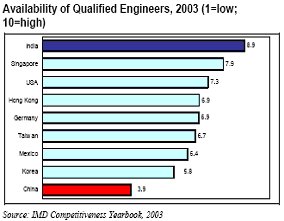|
Previous
Page - 3
The two countries have, however, followed two entirely different development models to reach their present positions.
Much of India's recent success is driven largely by private enterprise uniquely characterized by high RoEs (Return on Equity) combined with Asia's lowest debt-to-equity ratios. China, on the other hand, has had an FDI-driven, export-led model, which has effectively served as a substitute for domestic entrepreneurship. The most important difference between the two is that while China is a political economy where state intervention is still very high, India is the world's fastest growing free-market democracy.
India's model is termed as more sustainable than the East Asian one as it helps develop more efficient corporates, healthier banks, more robust service industries and a bigger consumption base. However, there is a lot of catching up to do in terms of infrastructure development and reforms. India's economic reforms began only in 1991 more than a decade after China began liberalizing. In addition, India has had to make do with a national savings rate half that of China's and 90 percent less FDI. China, on the other hand, needs to pay attention to educating more people. It has only 1.5 million college students, out of a total population of over 1.3 billion as against India's 3 million graduates, 700,000 post-graduates and 1,500 PhDs. Such low-cost and skilled workers will change the work dynamics in many markets.

Next
* Contributed by: -
Amit Sharma & Ashwin Jayashankar,
PGDIM XI,
NITIE, Mumbai.
|
 |
 |
|